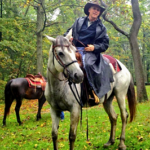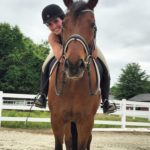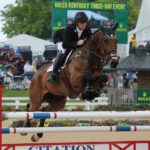I count on Italy–and, by extension, the horses–being laid-back. If I fall, I hope to land under a fig tree where someone will bring me wine.

I email equestrian-travel specialists Cross Country International, explaining that I’d competed as a junior, done hunter paces–but since an auto accident, I’ve had real limitations. I lost one arm; the fingers on the remaining hand are gone. I can’t tack up or even get on by myself. I just recently started lessons again.
The return message reads, “You must be able to canter with confidence in the open.”
It took 14 years for me to start over. For a long time I’d shut horses out, frustrated at not being able to ride at my previous level. Right-ankle nerve damage left my leg floppy, my balance compromised. Ongoing surgery and work on a journalism degree kept me busy. But at 37, the ache to ride has returned.
The handicapped riding programs all have waiting lists. Other stables refuse the risk I pose–until Robin Petersen welcomes me into her show barn, Back Bay Farm, in Ipswich, Mass. Robin holds my wrist from the off side so I can get on Kojak, her 25-year-old Cadillac of a horse. Not the safest method, but I know and loop the reins around my wrist. Robin quietly drills me on trot transitions and my posture. (That creaking sound: the leather or my joints?)
I devise a six-week regimen, riding four days a week at different barns, including lessons with Robin and with Jacqueline Falk, who gallops racehorses at the track every morning and teaches in the afternoons at Windkist Farm in Andover, Mass. Jacqueline gets poetic about the two-point zone of weightlessness: “Off his back, find the center, you are the center of your horse,” she chants. I ride William, a gelding, on the longe line without stirrups, losing myself in his fluid rhythm.
Knowing I’m on deadline, Jacqueline pushes me over crossrails with conviction. As I focus on the fences, old instincts resurface. I start looking ahead to the second or third rail in a line.
Close to “confident,” I pack my helmet and boots.
“Si, con cavallo,” I tell the taxi driver who asks twice if the Malvarina agritrismo is my destination. Up a zigzag dirt drive, past olive trees and corrals we climb. Sun-baked tile roofs and stucco buildings tell me I really am here. So does the lavish dinner. No TV, radio, or phone–just stars. Roosters, fresh ricotta cheese and espresso kick-start the morning.
My mount, Indio, looks like an overgrown carousel horses. His sweet face charms me–and he neck-reins. Other horses that owner Claudio Farizi uses are the reddish-colored Maremanna, a sturdy athletic breed from the south of Italy–“marinara horses,” one of my fellow riders calls them.
For two hours of steady climbing through olive groves, we follow Filippo, Claudio’s 17-year-old son, in his white cowboy hat. He impresses us by taking over the unruly mount of another guide. Seeing a landscape between pricked ears, I remember how being on trails adds a layer of sensor awareness. Damp manes, the sweet smell of leather and mingled sweat, the combined efforts make us part of the terrain.
On the mountaintop, any bravado gained on the way up evaporates as dark storm clouds rush in. A torrent of rain falls. My boots fill, squishing against my stirrups. Filippo uses his cell phone; shortly, a Jeep arrives with welcome ponchos. As we shimmy our way down the hillside, our group of six quickly bonds.
On my way to the clothes dryer, I step over snails headed toward a dog’s dish for the remnants of spaghetti.
At midday each day, our mounts tied under surrounding shade trees, we tuck into a feast spread on a tablecloth. So far the pace–an energetic walk, jog, some trots dictated by terrain–feels simple. But I am glad I prepared, not only for the saddle hours but for surprises. One mare’s knees fold coming down a hill (her rider steps off; she gets up; he remounts). One drops for a roll in the flowered grass. “Don’t worry, the horses know,” reassures Filippo during a steep butt-slide on a narrow twist of trail. Indio never puts a hoof wrong. Clattering on the cobbled lanes under the arches of Assisi, I feel truly invincible on my dappled, medievally-shaped mount.
On our last day, we ask for canters. Claudio obliges, leading us on a sandy track, the air swirling with monarch butterflies, then through a forest carpeted in pine needles. He warns us to follow in his hoof prints, and we scale a steep hillside for the valley view.
At the top, Claudio waves, and we take off across an open meadow. Indio’s rollicking rhythm keeps my balance intact. The hours of riding dispel years of regrets. I canter with ease.
Freelance journalist Holly Leigh Jacobson first
connected with Practical Horseman in 2001; this account of her return to riding after a devastating automobile accident appeared in the October 2001 “My Life” column. She has written other pieces for the magazine since and, as a regular at Robin Petersen’s Back Bay Farm (featured in the July 2007 issue), she made a substantial contribution to that story.








